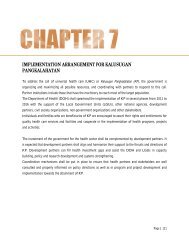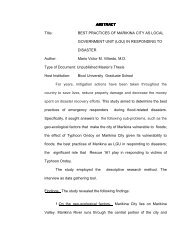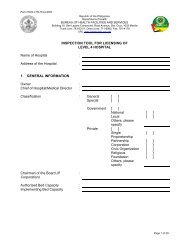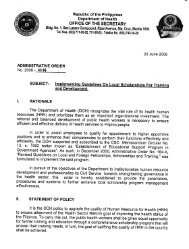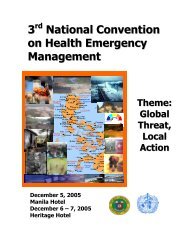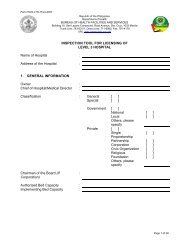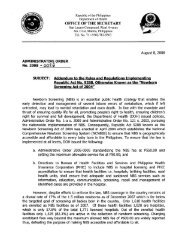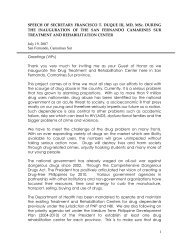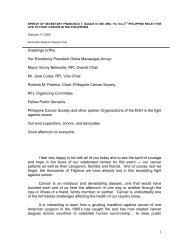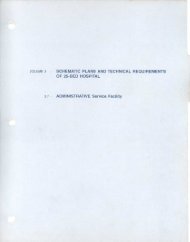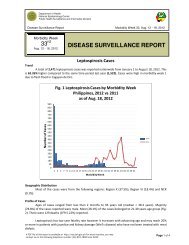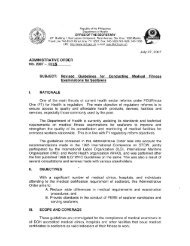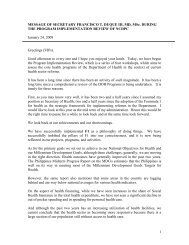Issue No. 69 - March - April 2012 - DOH
Issue No. 69 - March - April 2012 - DOH
Issue No. 69 - March - April 2012 - DOH
- No tags were found...
Create successful ePaper yourself
Turn your PDF publications into a flip-book with our unique Google optimized e-Paper software.
Dr Jonathan Sabadao (second year hand resident, left) and Dr. Ryan Ruiz (chief resident, center) ofthe Jose R. Reyes Memorial Medical Center Orthopedic Department treat Dennis Magat (Healthbeat'smanaging editor, right) who is suffering from trigger finger. (Photo by Paking Repelente)bent position. The problems often stemfrom inflammation of tendons that arelocated within a protective covering calledthe tendon sheath. People whose work orhobbies require repetitive gripping actionsare more susceptible. It is also more commonin women and in anyone with diabetes.Dr. Melito Antonio Ramos, formerVice Chair of the Jose R. Reyes MemorialMedical Center (JRRMMC) OrthopedicDepartment, explains that trigger finger is acondition that usually affects older persons.He added that it occurs becausethere is a disparity in size between the flexortendon and the surrounding retinacularpulley system, commonly known as the A1pulley, resulting to difficulty in flexing orextending the finger and the “triggering”phenomenon.Basically, the cause of triggerfinger is a narrowing of the sheath thatsurrounds the tendon in the affected finger.Tendons are fibrous cords that attach muscleto bone. Each tendon is surrounded by aprotective sheath — which, in turn, is linedwith a substance called tenosynovium. Thetenosynovium releases lubricating fluid thatallows the tendon to glide smoothly withinits protective sheath as the finger bends orstraightens like a cord through a lubricatedpipe.If the tenosynovium becomesinflamed frequently or for long periods,the space within the tendon sheath canbecome narrow and constricting. The tendoncan't glide through the sheath easily, attimes catching the finger in a bent positionbefore popping straight. With each catch,the tendon itself becomes more irritatedand inflamed, worsening the problem.With prolonged inflammation, scarring andthickening (fibrosis) can occur and bumps(nodules) can form in the affected finger/s.Diagnosis is made almostexclusively by history and physicalexamination alone. More than one fingermay be affected at a time, though it usuallyaffects the thumb, middle, or ring finger. Thetriggering is usually more pronounced in themorning, or while gripping an object firmly.Data presented at the 2005American College of Rheumatology NationalMeeting suggests that a majority of patientswith rheumatoid arthritis have inflammationaround the tendons of the palm of thehand that could develop into trigger finger.Also, prolonged, strenuous grasping mayaggravate the condition.In the Philippines, there is no exactdata on the number of affected Filipinos butDr. Ryan Ruiz, chief resident of the JRRMMCOrthopedic Department, approximates thatabout 25-30 patients every month are seenat the JRRMMC. If left untreated, this mayresult/progress to pain or restrictive fingermovement.He further explained that peoplewhose occupation requires mostly the useof their hands are prone to develop triggerfinger. Farmers, industrial workers, andmusicians are frequently affected by triggerfinger since they rely on their fingers orthumbs for multiple repetitive movements.The condition is more common in womenthan in men with a frequency of 2-6 timesand tends to occur most frequently in peoplewho are between 40 and 60 years of age. Thepeak incidence of trigger finger is observedamong individuals aged 55-60 years. Agedistribution has not changed significantlydespite repetitive tasks.Increased incidence of triggerfinger is observed in the dominant hand.The involvement of several fingers is notunusual. Triggering seems to occur morefrequently in patients with rheumatoidarthritis or diabetes mellitus. These patientsalso seem to be more resistant to injectiontreatment.One of the first symptoms oftrigger finger is soreness at the base ofthe finger or thumb. The most commonsymptom is a painful clicking or snappingwhen attempting to flex or extend theaffected finger. This catching sensation46 HEALTHbeat I <strong>March</strong> - <strong>April</strong> <strong>2012</strong>



